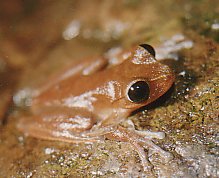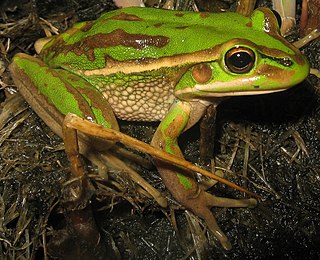
Litoria is a genus of hylid tree frogs, sometimes collectively referred to as Australasian treefrogs.

Nyctimystes is a genus of tree frogs in the subfamily Pelodryadinae of the family Hylidae. They are principally Papuan species, but also inhabit islands in the Moluccas. All species in this genus have one distinct feature that separates them from other species in the family, the lower eyelid is marked with pattern of lines, veins, or dots. This feature presumably acts as camouflage when the frogs are at rest during the day.

The Australian green tree frog, also known as simply green tree frog in Australia, White's tree frog, or dumpy tree frog, is a species of tree frog native to Australia and New Guinea, with introduced populations in the United States and New Zealand, though the latter is believed to have died out. It is morphologically similar to some other members of its genus, particularly the magnificent tree frog (R. splendida) and the white-lipped tree frog (R. infrafrenata).
The Pinocchio frog or northern Pinocchio treefrog is a species of frog in the subfamily Pelodryadinae. It was discovered in the Foja Mountains of Papua Province in Indonesia by Conservation International and the National Geographic Society during a 2008 expedition, where it was accidentally spotted by Paul Oliver, a herpetologist. Despite being discovered in 2008, it remained undescribed and was long known simply as the "Pinocchio frog" until 2019, when it was finally described as Litoria pinocchio. The frog is named for its Pinocchio-like nose, which can enlarge and inflate in certain situations. Although unusual, a similar nose is found in several other related frogs from New Guinea, including L. chrisdahli, L. havina, L. mareku, L. mucro, L. pronimia and L. prora.
Nyctimystes dux is a species of frog in the subfamily Pelodryadinae. This fairly large tree frog is mainly green. It is endemic to the Huon Peninsula in Papua New Guinea. It was separated from Litoria graminea by Richards & Oliver, 2006.
Nyctimystes purpureolatus is a species of frog in the subfamily Pelodryadinae. It is endemic to New Guinea and is known from its type locality on the Tiri River, a small tributary of the Mamberamo River in West Papua, Indonesia, and from three locations in West Sepik Province, Papua New Guinea.

Ranoidea is a genus of frogs in the subfamily Pelodryadinae. They are found in Australia, New Guinea, and two nearby groups of islands: the Maluku Islands, and the Louisiade Archipelago. The circumscription of this taxon is still controversial.
Ranoidea mira, also known as the chocolate frog, is a species of tree frog in the subfamily Pelodryadinae, and is part of the Ranoidea caerulea species complex. It was discovered in New Guinea by a research team led by Griffith University.
The montane Pinocchio frog is a species of frog in the subfamily Pelodryadinae. It is endemic to New Guinea. Scientists saw it on Hides Ridge in the karstic area of the Southern Fold Mountains in Papua New Guinea. Like the Pinocchio frog, it has a protuberance on its snout that can grow or shrink.
Nyctimystes hunti is a species of tree frog in the subfamily Pelodryadinae. It is endemic to northern Papua New Guinea. Scientists have seen it only in Utai, Sanduan Province, but predict that also lives elsewhere on New Guinea.
Nyctimystes sauroni is a species of tree frog and an endemic to Papua New Guinea Scientifically, it is in the subfamily Pelodryadinae. It is Scientists know it solely from the Kikori Integrate Conservation and Development Project area.
Nyctimystes pallidofemora is a species of tree frog in the subfamily Pelodryadinae, endemic to Papua New Guinea. Scientists disagree about whether this frog is best placed in the genus Nyctimystes or the genus Litoria.
Nyctimystes nullicedens is a species of tree frog in the subfamily Pelodryadinae. It is endemic to Papua New Guinea and has been found on the south-western side of Mount Obree, at 550 meters above sea level.
Nyctimystes kuduki is a species of tree frog in the sub-family Pelodryadinae. It is endemic to Papua New Guinea and is found in montane rainforests in Southern Highlands Province.
Litoria aplini, or Aplin's tree frog, is a species of frog in the family Hylidae endemic to Papua New Guinea. Scientists know it exclusively from the type locality: the upper reaches of the Sepik River in Sandaun Province.
Litoria haematogaster, also known as the red-bellied tree frog, is a species of frog in the subfamily Pelodryadinae. It was described in 2023 by Australian herpetologist Stephen Richards and his colleagues Stephen Donnellan and Paul Oliver. The specific epithet haematogaster comes from the Greek haema (‘blood’) and gaster (‘belly’), with reference to the frog's bright red abdomen.
Litoria daraiensis, also known as the Darai Plateau tree frog, is a species of frog in the subfamily Pelodryadinae. It was described in 2023 by Australian herpetologist Stephen Richards and his colleagues Stephen Donnellan and Paul Oliver. The specific epithet daraiensis refers to the type locality.
Litoria lisae, also known as Lisa's tree frog, is a species of frog in the subfamily Pelodryadinae. It was described in 2023 by Australian herpetologist Stephen Richards and his colleagues Stephen Donnellan and Paul Oliver. Both the common name and the specific epithet lisae refer to Stephen Richards' wife.
Litoria gracilis, also known as the slender spotted tree frog, is a species of frog in the subfamily Pelodryadinae. It was described in 2023 by Australian herpetologist Stephen Richards and his colleagues Stephen Donnellan and Paul Oliver.
Litoria naispela, also known as the Crater Mountain treehole frog, is a species of frog in the subfamily Pelodryadinae. It was described in 2023 by Australian herpetologist Stephen Richards and his colleagues Stephen Donnellan and Paul Oliver. The specific epithet naispela is a Tok Pisin term meaning ‘beautiful’ or ‘attractive’.



